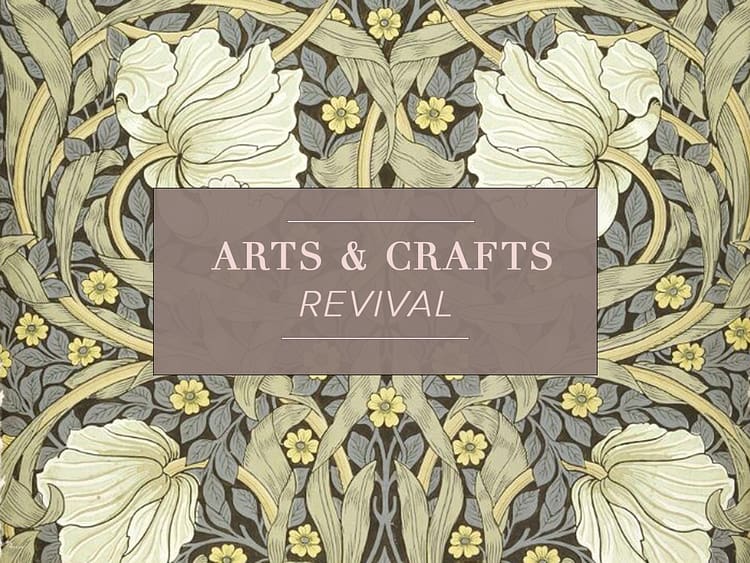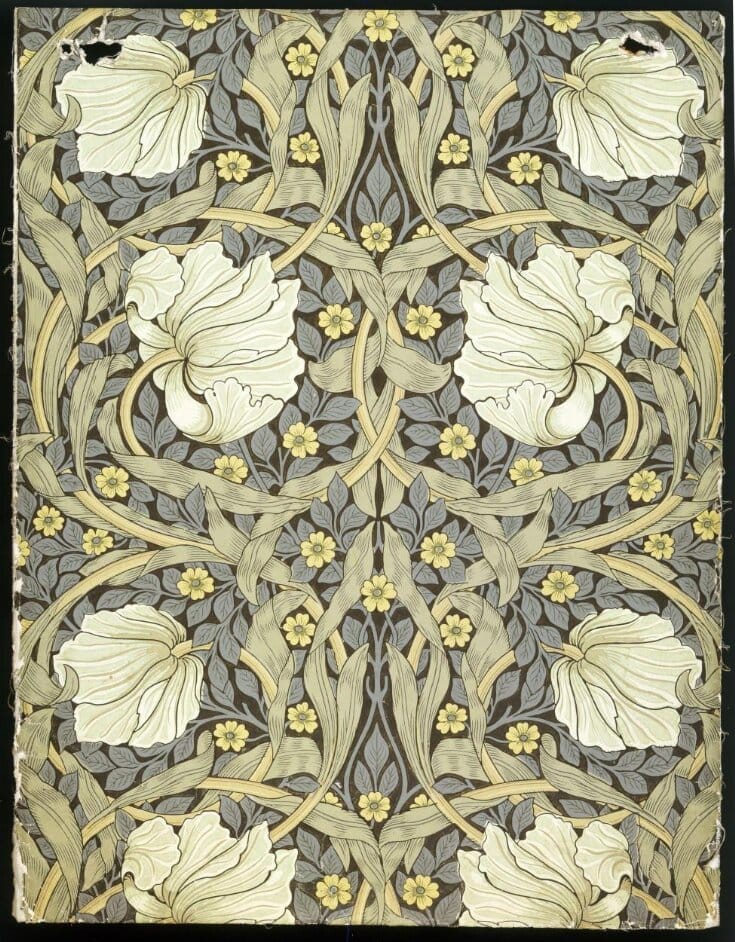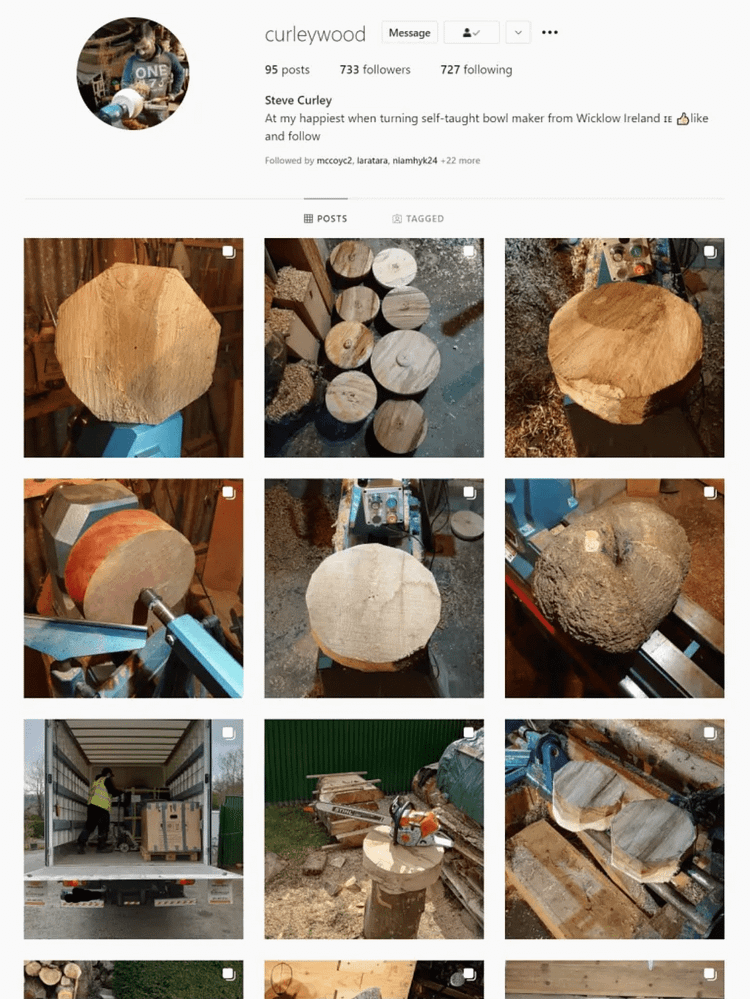
You can find all of my art blogs here! Also, please follow my art and design Instagram page _anitakenna_
INTRODUCTION
The arts & crafts movement began in Britain and spread across Europe and the USA over the late nineteenth to the twentieth century (1860-1910). The movement was a reaction against poorly made and mass-produced products and sought to restore dignity to traditional handicrafts. If you wish to learn more about the arts & crafts movement, read my blog post detailing its history and themes.
Upon review of the themes and beliefs of this movement, I considered how I see similar attributes arising in the current climate as I had observed a renewed love and a revival of the arts & crafts in recent years, especially during COVID-19. Therefore, I decided to investigate further to determine if there is indeed a revival of the movement.

(William Morris V & A Collection – Pimpernel – Green)
Due to my prior experience working in the Buying Department of Primark, I know first-hand the wastage that can occur in mass production (such as bulk clothing destroyed due to, for example, late deliveries). I have started to see a move away from mass production and bulk buying in recent years, mainly due to the impact of climate change. Also, I believe that younger generations value uniqueness, and there is a social shift from generic products to one-of-a-kind experiences or pieces of art/crafts.
I am hopeful of starting to create and sell art myself. Thus, my business development plan includes the need to research if the perception I had (concerning support for small businesses and locally sourced art/crafts) is indeed happening in Ireland.
PRIMARY RESEARCH
I previously studied Statistics as part of my degree at University College Dublin. Therefore, I understand how statistical findings can often be manipulated during research! For this reason, I chose to review and/or speak directly with some of my local people working in art/crafts.
Local Arts/Crafts People
1. Local Woodturner: Curleywood

I first spoke with a local woodturner, Steve Curley of Curleywood, and received some valuable input from him. Steve advised that he has observed significant growth in support of crafts in recent years and sees social media as a leading factor. After joining Instagram last year, Curleywood has grown to 700 followers for his woodturning page (with less than 100 posts). He notes that social media has allowed for the entry of individuals like him, who otherwise would be unable to get into the market, and that it provides them with an outlet to show their work and share the process of how it was created (allowing people to recreate the work themselves).
Also, Steve advised that he sees a societal class difference in sales, finding that those considered more ‘well-off’ tend to be more enthusiastic and willing to pay for one-off and unique items. Indeed, we are seeing a growing trend with people valuing unique elements rather than mass-produced/identical products. Previously, products with unique qualities were likely omitted (and wasted) in mass production due to the uniqueness being considered a flaw. Again, this is an example of a return to where uniqueness and local handicrafts were leading themes of the prior arts & crafts movement. Steve advised that he has sourced by-products (of wood) from a local tree surgeon and found the community keen to buy a local product made from local materials. Indeed, this is a fantastic example of ethical sourcing of local materials (in line with the arts & crafts movement).
2. Dublin Artist: Miriam Smithers

I also spoke with Dublin Artist Miriam Smithers, who has grown to 2.5k followers on her Instagram page. Miriam also advised that she has observed a growth in art/crafts in recent years – noting that many of her clients want an original piece of work/investment pieces and don’t want to spend small figures of money on generic products. I was surprised by Miriam’s feedback concerning COVID-19, whereby she believes that restrictions forced people to be ‘still’ and appreciate the hand-made, bespoke products and lend their support to the makers.
Following this feedback, I watched a ‘Nationwide’ episode on R.T.E. (May 12th, 2021). The show was about the vibrant arts scene in Cork over the lockdown period; details backed up Miriam’s statement as the artists expressed that a new love of art had occurred during the lockdown period, with people using it to express and communicate through it.
3. Wicklow Willow

Another local art/crafts couple doing exceptionally well over the last year is Wicklow Willow.
As per their website (2021), they provide “environmentally-friendly erosion solutions in the form of willow revetments”. The artists create not only sculptures but baskets and furniture as well. Furthermore, their business featured on R.T.E. television several times over COVID-19, with R.T.E. advising of their (Wicklow Willows) online workshops for families. Workshops included videos on how to sustainably forage materials within your 5km and how to create a shamrock yourself. These are fantastic example of themes in line with the prior arts & crafts movement.
Impressively one of their willow shamrocks was forwarded to the White House for St. Patrick’s Day!
Social & Cultural Context
As mentioned, climate change and lockdown increased interest in art/crafts. In recent years we are seeing a conscious social move away from mass production. Upcycling has become increasingly popular, with workshops often being offered by designers. Just last week (2nd June, 2021), textile repairer Molly Martin held an online workshop about repairing knitwear through darning. Also, ethical products, such as edible cups, are becoming more popular due to the impact of mass-produced and wasteful plastic cups.
A Key Factor in the Revival: Social Media
One of the most significant factors I see for this increased interest in art/crafts is the impact of social media on current society. Social media has enabled people to share, teach, and learn art/crafts easier than in years gone by. Indeed, there has been significant growth in video sharing over the last year (Instagram reels, YouTube videos, Etsy, online workshops/classes, Prosecco and Paint, etc.).
I also believe there’s a growing trend in purchasing hand-crafted items. Simon Davies (2016) of Socialnomics noted an ongoing struggle to be authentic on social media and stated that “(#folkart) is hugely popular on Instagram, with users posting pictures of the art they have made, bought or found with equally positive results”. This hashtag now has over 1.4M posts. I performed a search of this hashtag (see below). This search showed a strong influence of floral patterns and wood crafts – similar to the floral and handicraft themes seen in the prior arts & crafts movement.

Other Key Factors in the Revival
Also, there is growing popularity of people using art/crafts for Mindfulness and to switch off from the hectic lifestyles people are leading. The Crafts Council UK highlighted this in its 2020 report.
Finally, I see growing support for local small businesses. This factor was another key theme of the prior art/crafts movement. Especially during COVID-19, there was an increased push and advertising to support small local businesses. According to an article on buying local, Fingal news stated that “83% (are) now likely to “Look for Local” in Dublin”.
SECONDARY RESEARCH
The following sections again show recent themes emerging in arts & crafts in line with the prior arts & crafts movement, such as growth in arts & crafts (both personal and sales), preference for authentic, ethical and sustainable consumption and support of local products.
Hobbycraft / Socialnomic
I reviewed an article by the Guardian (Anonymous, 2020), which states that Hobbycraft reported a 200% boom in online sales since the start of the coronavirus pandemic as customers discovered new crafts during the lockdown. It noted that some of this is down to social media.
Also, Simon Davies (2016) of Socialnomics stated: “Any social media platform with an image-based element is likely to be populated by various pictures of homemade crafts. Instagram, for instance, is full of DIY-basses accounts…”. Furthermore, the article stated that Pinterest shows ‘Arts and Crafts’ as the second most popular topic – noting that video sharing (how-to videos) has assisted with this growth.
The Crafts Council (UK)
The Crafts Council (UK) released a publication in 2020 that highlighted many reasons for the dramatic growth in art/crafts between 2006-2020. For example, the “public’s desire for authenticity, for experiences, for ethical and sustainable consumption” and for “a concern for wellness and mindfulness, as well as the growing need to switch off from electronic devices”.
It advises that crafts have been strongly impacted by the rise of “new routes to market and digital selling platforms” since the early to mid-2000s. The sector is more democratic; makers no longer need to rely on a third party, studio, or physical presence to be able to sell internationally. It noted that online platforms had fuelled much of the growth – especially in international sales. Crafts Council further advised that consumers in 2020 are “younger, more ethnically diverse, less dominated by graduates and with lower specialist knowledge”. It also stated that there’s a growing number of people entering the market for buying craft from a living maker since 2006.
Irish News Publications
Concerning supporting local, the Irish Examiner (McCurry, 2020) noted that Irish consumers were making a significant effort to support local businesses during the coronavirus pandemic, while Breaking News (Anonymous, 2020) recognised a surge in support for small Irish businessess on social media.
My Modern Met
My Modern Met (Taggert, 2018) also wrote an interesting article on the revival of the arts & crafts movement (2018). It noted that more people are rejecting machine-produced products, instead favouring handmade items from independent retailers, crafters, and artists. It further stated that unlike in the prior arts & crafts movement, it does not “…completely reject modern technology, artists and consumers alike can use the Internet in their favor.”
SIMILARITIES TO PRIOR MOVEMENT

- Rejection: Rejection of mass production, instead focusing on art, design, and craftsmanship rather than industrialization.
- Support: Support of local materials and traditional building methods.
- Honest: An “honest” style, favourable of earthly tones – we often see this in current-day packaging (especially in brands encouraging ethical branding/eco-packaging).
- Focus on the applied arts.
- United in philosophy rather than strictly aesthetic style.
DIFFERENCES TO PRIOR MOVEMENT

- Technology: There is not evidence of a total shift from technology (as seen in the last arts & crafts movement). Indeed, technology is one of the underlying factors assisting with the modern arts & crafts movement! For example, social media facilitates an outlet for voices and recognition of art/crafts, online videos help with learning arts and crafts, Zoom classes facilitate learning, online workshops for upcycling, online painting with prosecco, etc.
- Affordability: The current-day movement is not really aimed as a move towards affordability items like the prior movement. Nowadays, many people are willing to pay more for a local product as a unique once-off piece.
- Decorative/Medieval: Decorative design is not of the utmost importance. The prior movement reminisced on medieval architecture, tapestries, illuminated manuscripts, rustic styles, and literature. The arts & crafts movement was a reaction against eclecticism, the clutter of ornamentation, and the often poorly made and mass-produced products of the Victorian Era. However, the current movement is more concerned with social awareness (climate change, support of small businesses), wellness/well-being, and a drive-in technology to share work.
- Floral, Organic, Nature Motifs: Though these themes are apparent in the current-day movement, they are more stripped-back with a modern/cleaner style than the prior art & crafts movement. We see this on, for example, the below Avoca packaging.

CONCLUSION/FINDINGS
What/Who is leading the movement?
No particular designer is leading this revival in the arts and crafts movement; it is more being led by a drive-in social media and climate change impact. Online content creators are assisting in bringing popularity back to arts & crafts in a big way. For example, Craftingeek is a Mexican YouTube crafter best known for her Craftingeek channel. She has over 1.6M followers and has gained widespread recognition for her detailed tutorials on DIY projects (that often feature her working with paper and recycled crafts).
There is thus a broader cultural and social influence in this movement. Social change, such as a cultural shift to communicate through social media, and the effects of climate change leading to a rejection of mass industrialization are also growing in popularity. Upcycling/sustainable fashion continues to gain in popularity as people reject mass production of work. Social media (reels, YouTube videos, etc.) has allowed more people to learn, participate, and share arts & crafts. Therefore, it is driving a move in arts/crafts and allowing people who may not have had the education to do this before to enter this world and have access to learn more about it with a lot of support available to them online.
Findings from My Research
I found from my primary research that, unlike the arts & crafts movement in the 1890s (aimed at creating affordable work), there is currently more of a move towards people being willing to pay for unique work and appreciating hand-made bespoke products.
While there’s been a growth in opportunities, this has also led to significant growth in competition. Creators often need to be extremely creative and active on social media to be successful. They will likely need to master other skills such as photography, marketing, and technology (e.g. video skills). Also, they will need to dedicate extra time to these new skills – which will likely impact their time dedicated to their arts/crafts.
Summary/My Thoughts
My findings show an increased interest in arts & crafts during the coronavirus lockdown – likely due to the extra time people spent at home. Economically, COVID-19 has caused a push towards supporting local businesses and materials during this time too. I believe that, as the world opens back up, interest in this will likely fade. However, I foresee a renewed interest in unique handmade crafts, a growth in learning arts & crafts through social media, and a rejection of mass production (especially in the textile industry) will remain for years ahead. From my studies, it is clear that social media is one of the main influences of this renewed movement in arts and crafts.
PICTOGRAPHY
Fig 1: William Morris (Designer), (no date), William Morris V & A Collection – Pimpernel – Green. Available at https://collections.vam.ac.uk/item/O248603/pimpernel-wallpaper-morris-william/ (Accessed: 27 Sept 2023)
Fig 2: Curley, Steven, (2021), Curleywood Instagram page. Available at https://www.instagram.com/curleywood/ (Accessed: 26 May 2021)
Fig 3: Smithers, Miriam, (2021), MiriamSmithersart Instagram page. Available at https://www.instagram.com/miriamsmithersart/ (Accessed: 26 May 2021)
Fig 4: Patterson, Aoife, (2023), WicklowWillow Instagram page. Available at https://www.instagram.com/wicklowwillow/ (Accessed: 30 Sept 2023)
Fig 5: Various, (2021), #FolkArt search on Instagram. Available at https://www.instagram.com/explore/tags/folkart/ (Accessed: 26 May 2021)
Fig 6: Anonymous (seastrands), (2020), Seastrands Packaging and Brand Identity. Available at https://www.behance.net/gallery/101774679/Seastrands-Packaging-and-Brand-Identity?tracking_source=project_owner_other_projects (Accessed: 26 May 2021)
Fig 7: William Morris (Designer), (no date) – MET Museum, (no date), Bird. Available at https://www.metmuseum.org/art/collection/search/221485#:~:text=Bird%20designed%201878,until%20his%20death%20in%201896 (Accessed: 30 Sept 2023)
Fig 8: Photographer Unknown – Avoca, (no date), Lemon Verbena Scented Candle. Available at https://www.avoca.com/en/homeware/candles-and-diffusers/lemon-verbena-scented-candle (Accessed: 28 April 2021)
BIBLIOGRAPHY
Anonymous, (2020) “83% now likely to “Look for Local” in Dublin”, Fingal County Council, 16 December. Available at https://www.fingal.ie/news/83-now-likely-look-local-dublin (Accessed: 30 Sept 2023)
Anonymous, (2020), “Hobbycraft reports 200% boom in online sales since start of pandemic”, The Guardian, August. Available at https://www.theguardian.com/business/2020/aug/03/hobbycraft-reports-boom-in-online-sales-since-start-of-pandemic-crafts-coronavirus (Accessed: 26 May 2021)
Davies, Simon, “Social Media is Bringing Traditional Arts and Crafts into the Future” [on-line], 2016, at https://socialnomics.net/2016/12/05/social-media-is-bringing-traditional-arts-and-crafts-into-the-future/ (Accessed: 26 May 2021)
Crafts Council, “The Market for Craft, Commissioned by the Crafts Council and Partners” [on-line], 2020, at https://www.craftscouncil.org.uk/documents/880/Market_for_craft_full_report_2020.pdf (Accessed: 26 May 2021)
McCurry, Cate, (2020), “Survey: Irish consumers making big effort to support local businesses during pandemic”, The Irish Examiner, 08 November. Available at https://www.irishexaminer.com/news/arid-40077941.html (Accessed: 26 May 2021)
Anonymous, (2020), “Surge in support for small Irish businesses seen on social media”, Breaking News, 16 November. Available at https://www.breakingnews.ie/business/surge-in-support-for-small-irish-businesses-seen-on-social-media-1036923.html (Accessed: 26 May 2021)
Taggert, Emma, “The Revival of the Arts and Crafts Movement and the Artisans Behind It” [on-line], 2018, at https://mymodernmet.com/arts-and-crafts-movement-revival/ (Accessed: 26 May 2021)
Wicklow Willow, Website Homepage [on-line], 2021, at https://wicklowwillow.ie/?fbclid=IwAR0SH7xgphX8Ivrx8b7JR62TRPn_indV3_Xt8yXM0Pr2sv5UldCczGKbRWg (Accessed: 26 May 2021)
Event Source
Event Knitwear Darning with Molly Martin (2021), Available at https://www.eventbrite.ie/e/toast-knitwear-darning-with-molly-martin-tickets-152367608619?aff=ebdssbonlinesearch&keep_tld=1 (Accessed: 26 May 2021).



0 Comments